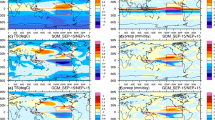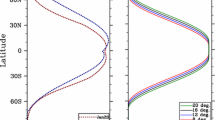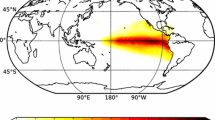Abstract
The relative importance of sea surface temperatures (SSTs) and the surface energy budget to tropical precipitation is examined by comparing models with zonally symmetric climates, both fixed SST and coupled to a slab mixed layer ocean. Two models are considered with differing surface flux formulations and in each case solutions that are symmetric about the equator are perturbed to create interhemispheric asymmetry. When SSTs are prescribed in the two models with different flux formulations, the magnitude of tropical precipitation response to identical SST anomalies is significantly different, but the differences can be understood in terms of the altered surface fluxes. In contrast, when the net surface energy fluxes are constrained to be identical in mixed layer simulations of the two different models, the response of tropical precipitation to perturbations in the surface energy balance is very similar. Both perspectives predict qualitatively the same precipitation response, but the energy budget better predicts the magnitude of the precipitation response. Thus, we argue that the atmospheric energy budget, controlled in these experiments primarily by the surface energy budget, is more fundamental to the control of tropical precipitation than the SSTs, in these simulations with axisymmetric climates. We touch briefly on a complication in the interpretation of the model results due to the fact that fixed SST and slab-ocean versions of the model can produce different Hadley cell strengths for the same SSTs.






Similar content being viewed by others
References
Anderson J et al (2004) The new GFDL global atmosphere and land model AM2–LM2: evaluation with prescribed SST simulations. J Clim 17:4641–4673
Back LE, Bretherton CS (2009) On the relationship between SST gradients, boundary layer winds, and convergence over the tropical oceans. J Clim 22:4182–4196
Chiang JCH, Zebiak SE, Cane MA (2001) Relative roles of elevated heating and surface temperature gradients in driving anomalous surface winds over tropical oceans. J Atmos Sci 58:1371–1394
Frierson DMW, Held IM, Zurita-Gotor P (2007) A gray-radiation aquaplanet moist GCM. Part II: energy transports in altered climates. J Atmos Sci 64:1680–1693
Gill AE (1980) Some simple solutions for heat induced tropical circulation. Q J R Meteorol Soc 106:447–462
Kang SM, Held IM, Frierson DMW, Zhao M (2008) The response of the ITCZ to extratropical thermal forcing: idealized slab-ocean experiments with a GCM. J Clim 21:3521–3532
Kang SM, Frierson DMW, Held IM (2009) The tropical response to extratropical thermal forcing in an idealized GCM: the importance of radiative feedbacks and convective parameterization. J Atmos Sci 66:2812–2827
Lindzen RS, Hou AV (1988) Hadley circulations for zonally averaged heating centered off the equator. J Atmos Sci 45:2416–2427
Lindzen RS, Nigam S (1987) On the role of sea-surface temperature-gradients in forcing low-level winds and convergence in the tropics. J Atmos Sci 44:2418–2436
Neelin JD (1989) On the interpretation of the Gill model. J Atmos Sci 46:2466–2468
Neelin JD, Held IM (1987) Modeling tropical convergence based on the moist static energy budget. Mon Weather Rev 115:3–12
Author information
Authors and Affiliations
Corresponding author
Rights and permissions
About this article
Cite this article
Kang, S.M., Held, I.M. Tropical precipitation, SSTs and the surface energy budget: a zonally symmetric perspective. Clim Dyn 38, 1917–1924 (2012). https://doi.org/10.1007/s00382-011-1048-7
Received:
Accepted:
Published:
Issue Date:
DOI: https://doi.org/10.1007/s00382-011-1048-7




